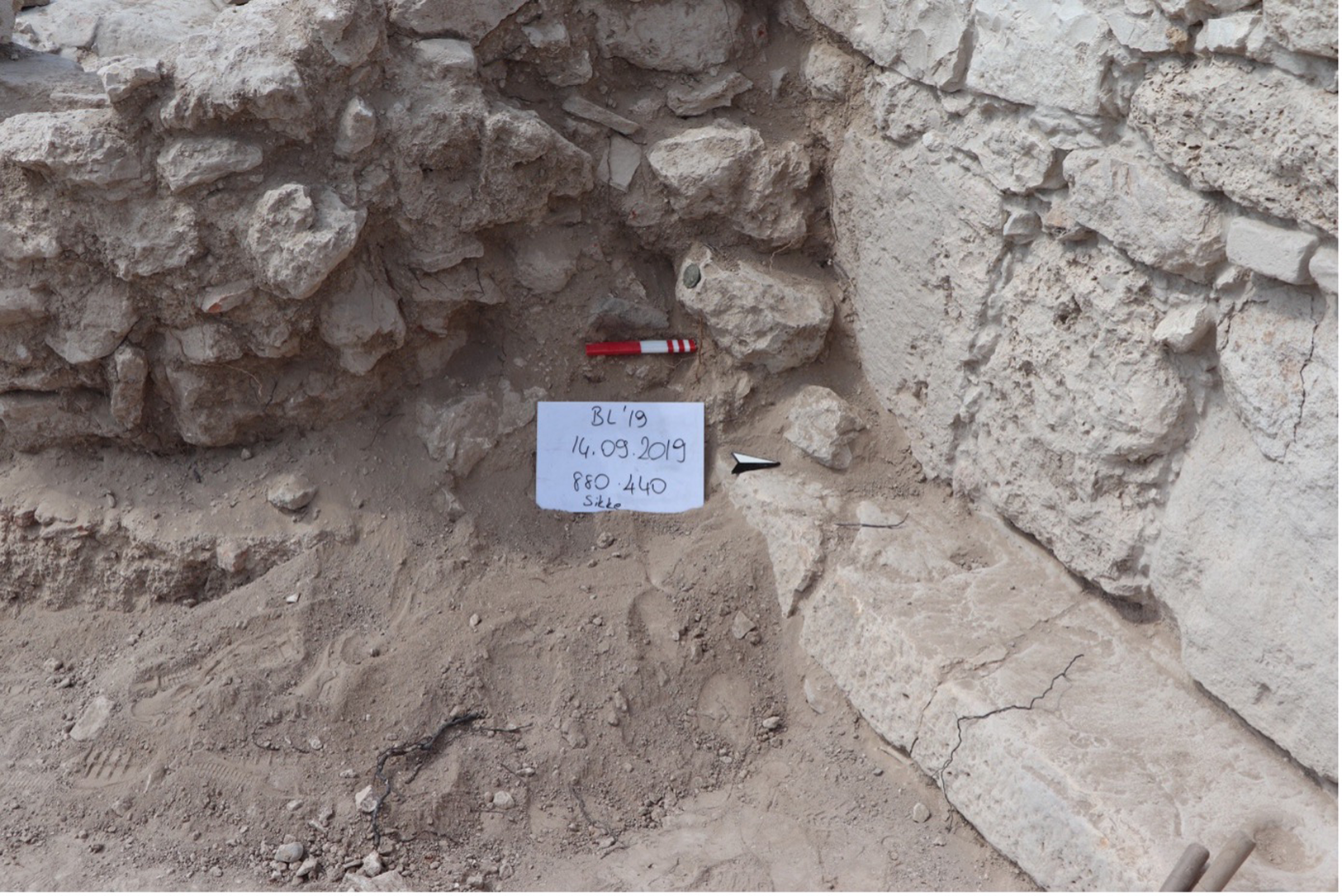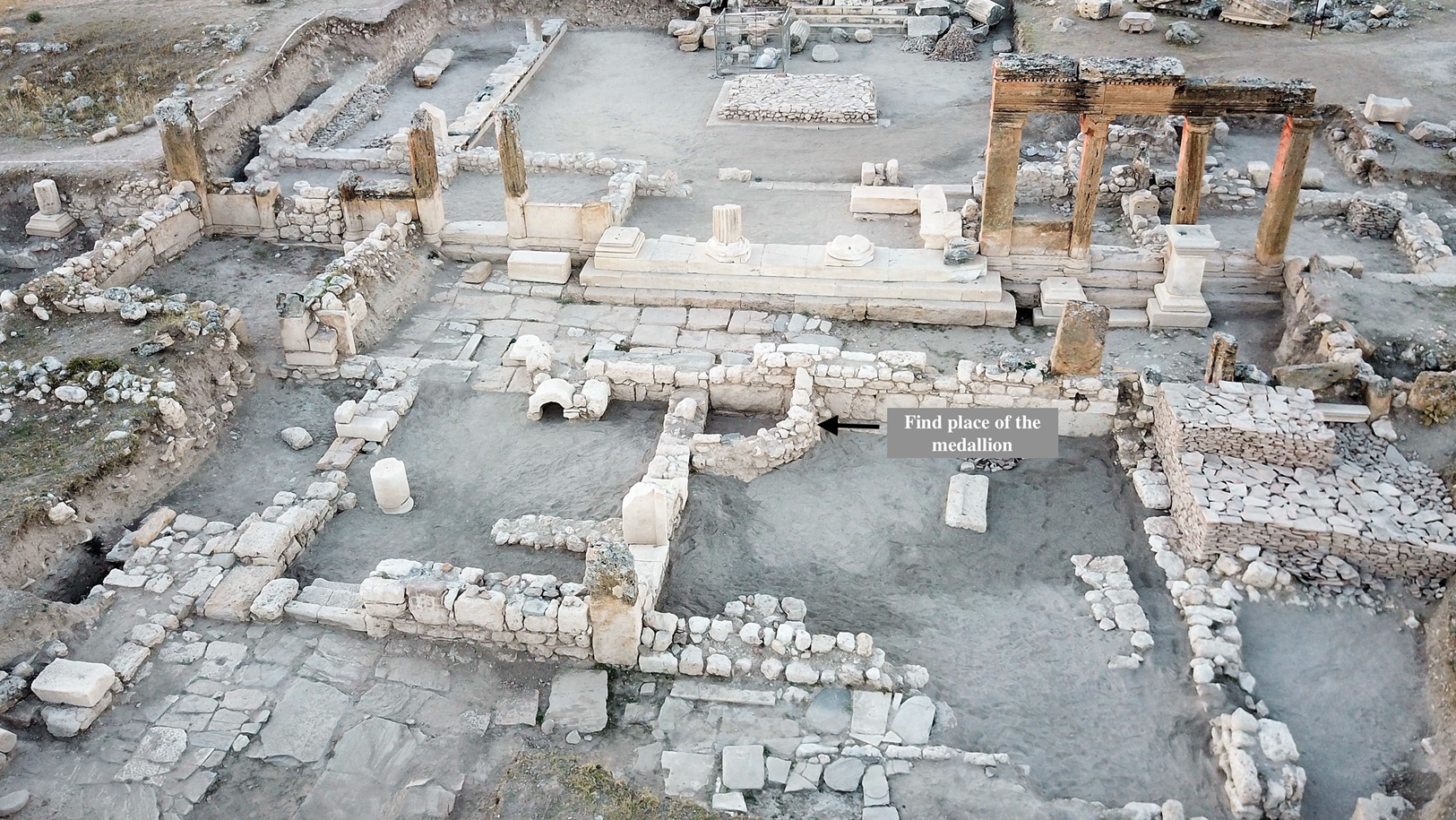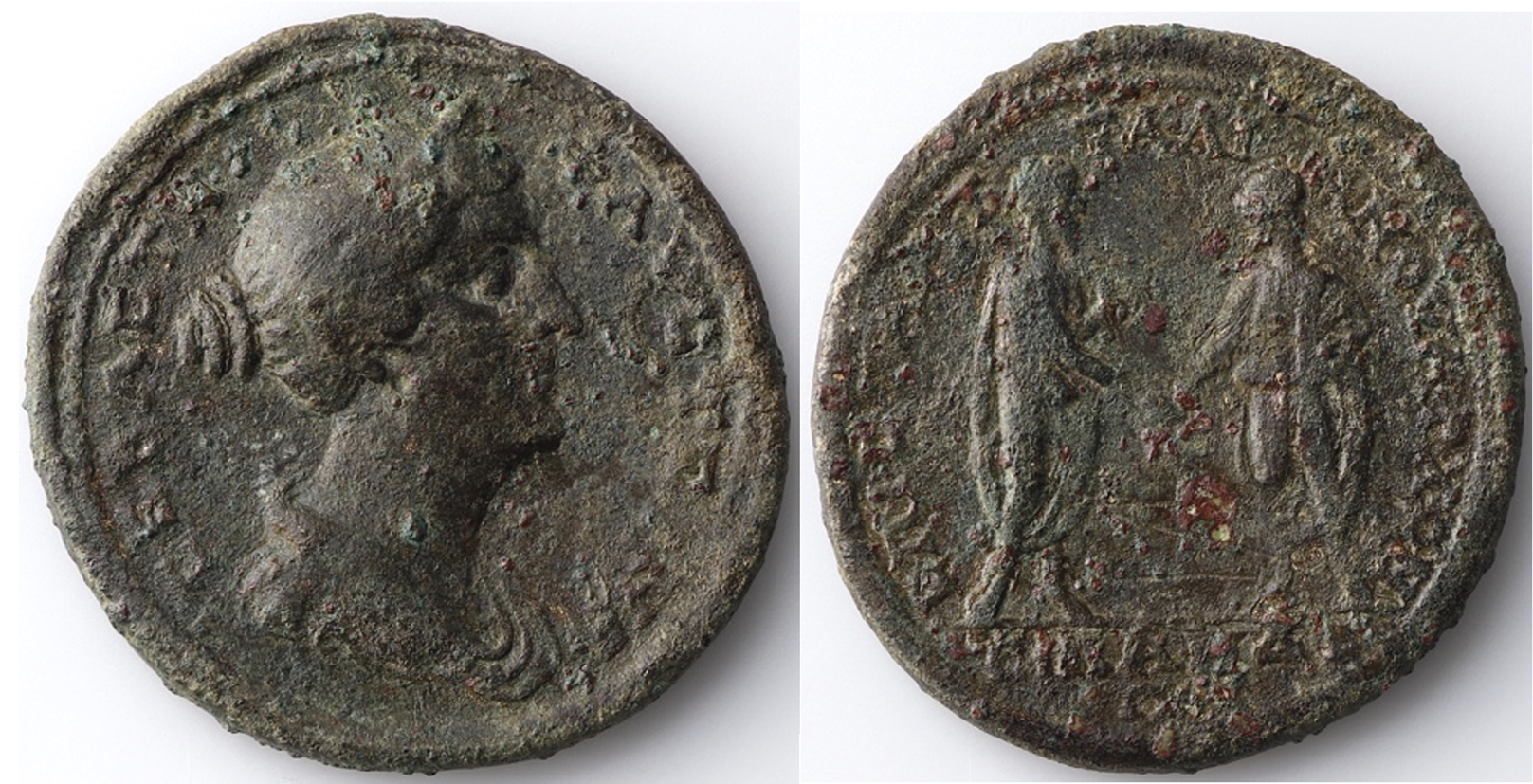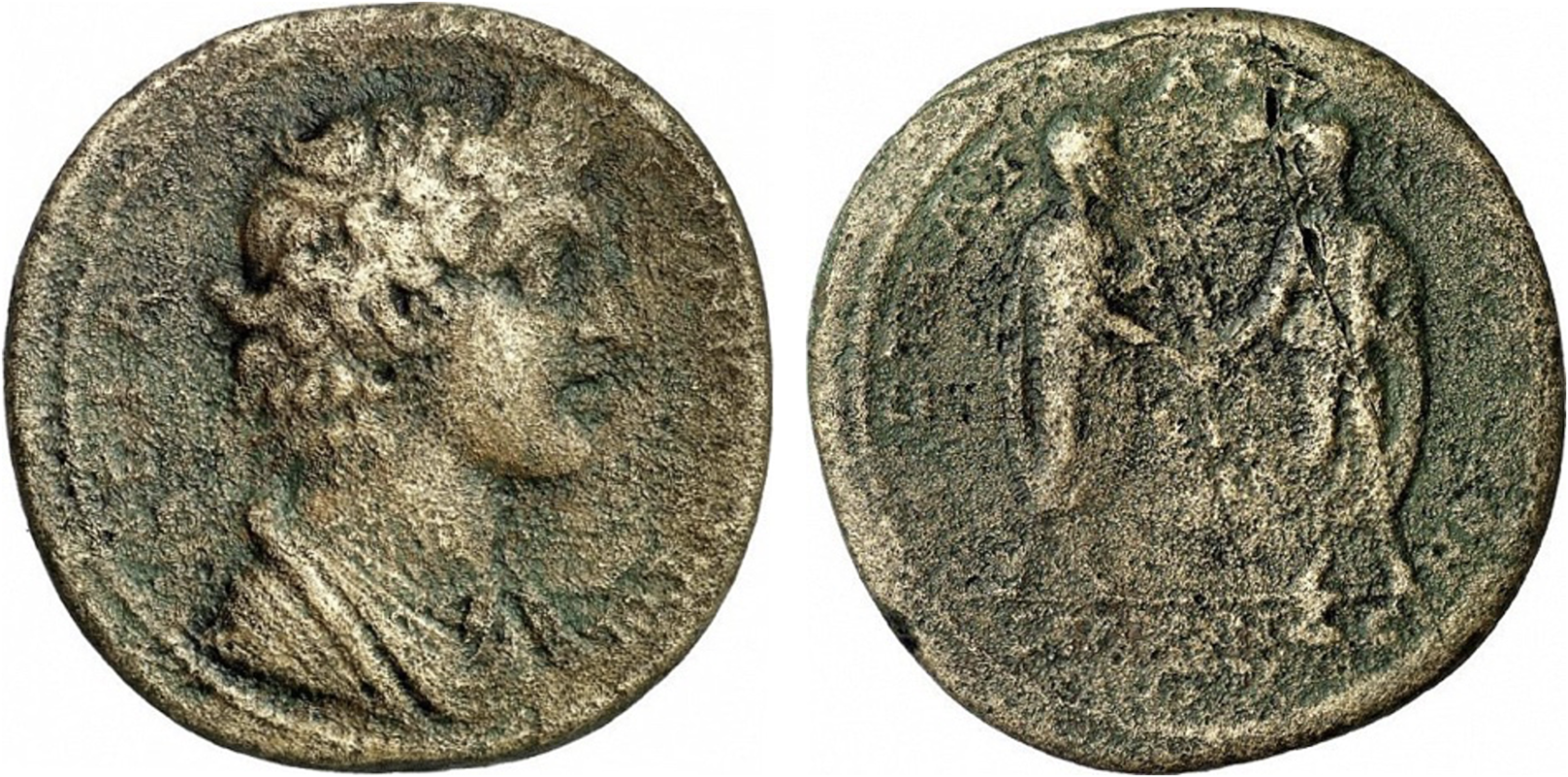During archaeological excavations carried out in 2019 in the ancient city of Blaundos in Lydia, a medallion struck by Silandos that is the main subject of this study was found on the wall of a Byzantine-era workshop located on the main street of the city (Fig. 1).Footnote 1 The wall belongs to a small circular storage room in the left-hand corner of the structure (Fig. 2). It is thought that this structure, situated on the main street, is a workshop and the small room is a storage space as archaeological materials such as a pithos and loom weights were found there in situ.Footnote 2 The medallion, on the other hand, was found within the dirt of the wall fill. As the outside of the wall was muddy and dirty, the excavation team decided to clean it, and this led to the discovery of Silandos medallion. This location rules out the possibility of a ritualistic use related to foundation rites.Footnote 3

Fig. 1. Find place of the medallion. (Blaundos excavation photo archive; courtesy B. Can.)

Fig. 2. Aerial view of the main street, the Byzantine-period structure, and the storage room. (Blaundos excavation photo archive; courtesy B. Can.)
The object in question is a medallion minted in Silandos during the joint reign of Marcus Aurelius and Lucius Verus (Fig. 3). It is 45 mm in diameter and 49.36 gm in weight. It bears the draped and topknotted bust of Faustina II, r., wife of M. Aurelius, on the obverse. The legend reads CEBACTH ΦAVCTEINA. On the reverse side, the co-emperors Marcus Aurelius and Lucius Verus, each wearing a toga, stand facing each other, clasping their right hands and holding scrolls in their left hands. The reverse legend reads EΠΙ CTA ATTAΛIANOV APXON CIΛANΔEΩN. The medallion in question is significant because it has not yet been published in de facto numismatic catalogs, nor in recent numismatic literature.Footnote 4 Roman Provincial Coinage (RPC) does not record any example.Footnote 5 No specimens sold at auctions could be identified either.

Fig. 3. Roman Medallion found in Blaundos excavations in 2019, Inv. no. BL’19-880.440-16. (Blaundos excavation photo archive.)
The obverse iconography is of no additional importance or reference value given the widespread use of empress busts on Roman coins. It has a plain appearance, very close to the portrait of Faustina II on other coins and medallions of the period.Footnote 6 The depiction of the empress is nearest to what is called “a young matron.”Footnote 7 The reverse type, on the other hand, does have a political reference. Marcus Aurelius, who ruled from 161–180 CE, shared the administration of the empire with his adoptive brother Lucius Verus between 161 and 169 CE. In this context, the iconography of two emperors shaking hands on the reverse contains a basic metaphor that they ruled in harmony. In fact, it marks one of the earliest expressions of the theme of dynastic harmony.Footnote 8 This iconography was introduced in Rome soon after the emperors’ joint accession in 161 CE, and it appeared on the coins of the next year.Footnote 9 Similar iconography was used on issues of the Rome mint, but this reverse type was not used on a medallion struck in Rome.Footnote 10 On the other hand, the type is used on coins of relatively larger denominations such as dupondius and sestertius.Footnote 11
On the Roman coins too, the two emperors are depicted standing and holding scrolls, clasping their hands. These issues bear the inscription CONCORD AVGVSTOR (concordia augustorum).Footnote 12 On the other hand, none of these issues has Faustina II as the obverse type. As the Blaundos example is a medallion and has a larger surface, it displays a higher artistic quality and a more pronounced and detailed reverse die. Therefore, there are very small differences from those that were struck in Rome in this regard. However, it is clear that this reverse type was copied from issues struck in Rome given the posture of the two emperors, their position, and their royal apparel as in the provincial type.
The magistrate mentioned on the reverse of the coin is Attalianos.Footnote 13 In the city of Silandos, where the medallion was minted, Attalianos was the first archon, between 163 and 165 CE, during the reign of Marcus Aurelius and Lucius Verus. Therefore, we can suggest this date range for the minting of the medallion discussed here. Apart from the Silandos medallion, there are 14 different coin series with Attalianos's name on the reverse.Footnote 14 Two series among them are medallions just like the Faustina II issue discussed here. The first one, with a diameter of 41 mm and weighing 52.23 gm, has the draped bust of a youthful personification of the Senate on the obverse with the inscription IEPA CVNKΛHTOC, and the emperor Lucius Verus in military dress, galloping over a kneeling and bound captive, r., on the reverse side. The reverse legend is EΠΙ CTA ATTAΛIANOV APXONTOC CIΛANΔEΩN.Footnote 15 The other medallion is interesting in that its reverse type is the same as the Silandos medallion. It is 45 mm in diameter and 52.69 gm in weight. The obverse type, on the other hand, is the same as one just described. It bears the draped bust of the youthful Senate and the legend IEPA CVNKΛHTOC.Footnote 16 The reverse depicts the two emperors, Marcus Aurelius and Lucius Verus, standing facing each other, clasping hands. Like the reverse type, the reverse legend is the same as the Faustina II medallion: EΠΙ CTA ATTAΛIANOV APXON CIΛANΔEΩN (Fig. 4).Footnote 17 It is clear that these two coins, which have the same reverse iconography and legend, were minted from the same reverse die. Thanks to the new specimen found in Blaundos, the number of known samples with this reverse type is now three, all sharing the same reverse die.Footnote 18

Fig. 4. Another medallion struck by Silandos, which shares the same reverse die as the one found in Blaundos. (RPC online: https://rpc.ashmus.ox.ac.uk/coins/4/1497.)
The iconography of these two emperors clasping hands appears to have been quite popular in the provinces as well.Footnote 19 The popularity of this motif is interesting because provincial issues tend to depict local themes on their reverses.Footnote 20 In addition to the Lydian city of Silandos, 24 different cities struck coins with this type on the reverse.Footnote 21 None of them has Faustina II as the obverse type. Moreover, none of these coins are medallions except for two different issues of Pompeiopolis in Cilicia.Footnote 22 The mints that struck coins with this reverse typeFootnote 23 are Pautalia, Philippopolis, Hadrianopolis and Perinthos in Thrace,Footnote 24 Tium in Bithynia,Footnote 25 Cyzicus in Mysia,Footnote 26 Phocaea and Magnesia ad Maeandrum in Ionia,Footnote 27 Heraclea Salbace in Caria,Footnote 28 Laodicea ad Lycum in Phrygia,Footnote 29 Selge and Adada in Pisidia,Footnote 30 Side in Pamphylia,Footnote 31 Pessinus in Galatia,Footnote 32 Diocaesarea, Pompeiopolis, Tarsus, Adana, Elaeusa-Sebaste, and Hierapolis-Castabala in Cilicia,Footnote 33 Amasea in Pontos,Footnote 34 Antioch and Neapolis in Syria-Syria Palaestina,Footnote 35 and Alexandreia in Egypt.Footnote 36 So, the type used on the reverse side of the Faustina II medallion is not an unusual one, either for Silandos or for a medallion in the general sense. It is a very common type used on regular imperial and provincial coins. On the other hand, Silandos is the only Lydian city currently known to have used that reverse type. However, it is interesting to note that, as stated below, none of these issues, neither the coins nor the medallions, carry the bust of Faustina II on the obverse side. While the reverse type seems rather common, the combination of the empress and that reverse type is at present peculiar to Silandos. It is not possible to say for certain why such a combination – Faustina on the obverse and two emperors on the reverse side – was preferred by this city nor what incident might have led to such a choice.Footnote 37 The apparent theme is the depiction of the empress with the co-emperors of the period. However, the primary reason for producing this medallion, as in the Roman coins bearing the same reverse type, must be related to the enthronement of the co-emperors. As stated above, this reverse type was used by the Roman mint in 161 and 162 CE. The period in office of the magistrate Attalianos is 163–165 CE. This Silandos medallion was probably struck in 163 CE. The other medallion struck by Silandos using the same reverse die confirms such an implication, since the reverse die used on that second medallion is much more worn than the Faustina medallion. On this basis, it is possible to suggest 164 or 165 CE for the second piece.
It is worth mentioning here another issue with a similar iconography. It is again a rare medallion struck by Silandos, and it is in the name of Iulia Domna, wife of Septimius Severus (r. 193–211 CE).Footnote 38 It bears the name of the magistrate Helenos, son of Apollonidos, on the reverse side.Footnote 39 What makes this medallion interesting is that it bears the head of the empress on the obverse side and co-emperors Caracalla and Geta (who ruled jointly between 209 and 211 CE) clasping hands, wearing togas, and holding scrolls. Like the Faustina medallion, it combines the iconography of an empress and co-emperors. Perhaps it was struck, like the former, to mark the beginning of the new era when Geta became co-ruler. On the other hand, it might have been struck before this period as well because there are other coins from the mint of Rome dated before 209 CE that show Caracalla and Geta clasping hands, as on the Silandos medallion.Footnote 40 However, those dated after the enthronement of Geta are more numerous.Footnote 41
Many coins bear the portrait of Faustina II, and they cannot all be listed here. Apart from those struck by imperial mints, 108 different cities used her portrait on their provincial coinage. The portrait of Faustina II was used frequently on medallions as well. There are ten issues struck by the mint of Rome.Footnote 42 The provincial cities known to have struck medallions with the depiction of empress on the obverse side are Serdica in Trace, Pergamon in Mysia, Hierocaesarea in Lydia, and Phocaea in Ionia.Footnote 43 The bust on the obverse of one of the Phocaea coins and the Hierocaesarea coin is positioned to the left.Footnote 44 In the remaining five medallions, the empress bust is facing right, as is the case in the Silandos medallion. But unlike the reverse die, a die link to any other obverses cannot be established. The obverse inscription of the Silandos medallion is CEBACTH ΦAVCTEINA. Other provincial issues have it as ΦAVCTEINA CEBACTH. Such a difference is based on the starting point of the legend and has no further significance.
No other Roman provincial issue, neither medallion nor regular coin, is known to have been struck by Silandos with a bust of Faustina II on the obverse. However, there are three different coins of the city bearing the portrait of Lucilla, the wife of Lucius Verus. The reverse inscription of these coins is ΛΟVΚΙΛΛΑ CEBACTH. None of them is a medallion. The reverse type of the first is the cult statue of Kore of Sardis standing and facing. It only carries the name of the city (CIΛANΔEΩN).Footnote 45 The reverse iconography of the other two series depicts Zeus Lydios standing and facing left.Footnote 46 These coins also bear the name of Attalianos, the archon of Silandos. The reverse inscription of the first coin is EΠI C ATTAΛIA CIΛANΔE, while the second reads [EΠI C?] ATTAΛIA CIΛAN. The result of the Faustina II obverse-depiction coin found in the 2019 excavations indicates that during Attalianos's period of office, coins with the portraits of both empresses were struck by the Silandos mint.
Silandos is one of the most prolific mints for the production of Roman medallions. Despite the fact that it only minted provincial coinage during the reign of four emperors from the 1st c. CE to 3rd c. CE, there are now 11 different known medallions.Footnote 47 The Faustina medallion is a significant specimen not only because it has never been published or appeared in an auction, but also because it bears a unique combination of obverse and reverse types. This piece, to conclude, most probably was struck to celebrate the enthronement of co-emperors M. Aurelius and L. Verus in the early phase of Attalianos's service. Regarding its findspot, the specimen from Blaundos should not be considered a ritual deposit as it was not found directly inside the wall or its nogging, or between blocks. It is also hard to explain why we found this piece in Blaundos. The fact that it was found in a Byzantine-period workshop also makes it difficult to establish its original context. Considering the fact that medallions were presented to members of local elites, perhaps it was given to such a person living in Blaundos. This movement of the medallion is most likely explained as the result of some relationship between two nearby cities.
Catalogue
Reign: Marcus Aurelius
Province: Asia, Conventus of Sardis
City: Silandos
Magistrate: Sta. Attalianos (first archon)
Dating: 163–165 CE
Obverse: CEBACTH ΦAVCTEINA. Draped bust of Faustina II, r.
Reverse: EΠI CTA ATTAΛIANOV APXON CIΛANΔEΩN. Marcus Aurelius and Lucius Verus standing facing each other, each wearing a toga, clasping their right hands and holding scrolls in their left hands
Metal: AE
Diameter: 45 mm
Weight: 49.36 gm
Inv. no.: BL’19-880.440-16 (Main Street/Byzantine structure)
Competing interests
The author(s) declare none.








